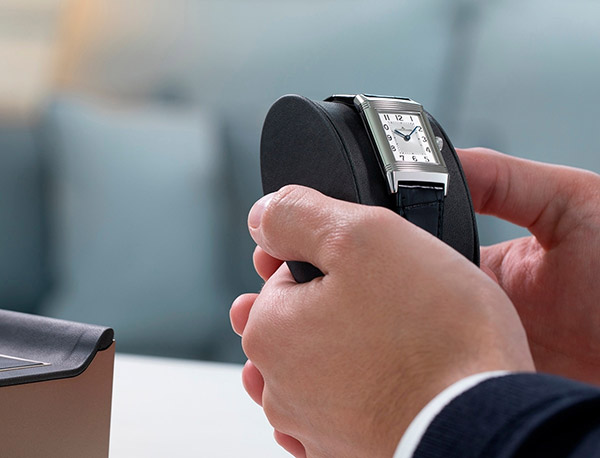- Blog
- Brand Story
- Switzerland
Jaeger Lecoultre: A Watchmaker to The Watchmakers
- 9th Oct 2020
- 2652
- 0

The brand known for “Haute-Horlogerie”, Jaeger LeCoultre is for the taste of every watch connoisseur. It is the 36th most recognized Swiss brand name in the world and the 14th most famous Swiss watch brand.
One thing everyone in the world knows about watches is that buying a Swiss watch is the nearest to a guarantee of excellence you can get in today’s world. As an advertisement for Zurich Airlines says “Like shopping for a Swiss watch. Hard to make a mistake.” Going back to the days of the pocket watch, throughout the foundation of the Japanese watch industry, during the quartz crisis and after the release of the Apple watch — Swiss still remains at its best.
The haute-horlogerie industry has its root tied to a few classical brands who never fail to claim their everlasting charm. One of such iconic Swiss watches, a brand to whom “The future was as important as the past” is Jaeger LeCoulter.
Well, as the old saying goes “ To know your future, you must know your past”, this blog takes you on to the journey of discovering the long-endearing historie (history) of the Maison.
Origin of the brand

Amidst the serenity of white snow capped Swiss Alps, Jaeger LeCoultre silently ensures the clock steadily marches forward. With its history dated back to 16th century, it was in 1833 when Pierre LeCoultre fled to Le Sentier in the Vallee de Joux, in the Swiss Jura Mountains, the company’s seed was sown, which eventually gave rise to “the Manufacture Jaeger-LeCoultre”, making it one of the first watch manufacturers to produce and assemble its own watch pallets. Le Sentier — the heartland of Swiss watchmaking remains home of Swiss watchmakers like Patek Philippe, Vacheron Constantin, Gérald Genta.
The Manufacture, today, conducts one hundred and eighty different expert skills brought together under its one roof, who together continue to work their everlasting ticking magic.
What makes Jager LeCoultre iconic?

Investing in a JLC is like investing in a good bottle of wine. It only becomes more valuable and astonishing with the age.
The brand known for “Haute-Horlogerie”, Jaeger LeCoultre is for the taste of every watch connoisseur. It is the 36th most recognized Swiss brand name in the world and the 14th most famous Swiss watch brand. JLC is respected and known for its most creative and inventive watchmakers in the industry with their high complication watches and innovative designs.
Inventors and not mere watchmakers:

Unlike most of its competitors, Omega and Rolex, the Maison remains relatively less conventional. Known for their meticulous attention to detail, perfection, and beautiful lines, JLC watches are highly appreciated by the watch collectors. The luxury watch brand has earned its unique recognition for its close association with its age old traditions and ever challenging innovations, which has served as significant component to their successful journey.
Commencing with Antoine LeCoultre, in 1844, LeCoultre had invented the most precise instrument capable of measuring time in the world — “the Millionometre”. It was the first instrument capable of measuring the micron which helped to refine the manufacture of watch parts and establish the metric system as the standard for watch measurement.
Heading it’s way to establishing another landmark, in 1847
LeCoultre designed a keyless push button to rewind and set watches. This inconceivable contraption was of course, not overlooked. Four years later, in 1851, LeCoultre was awarded a gold medal for his work timepiece precision and Mechanization at the first Universal Exhibition in London. The brand had now established themselves as originators in the world of watches. By 1866, LeCoultre’s workshop had risen out of the common home-run manufacturers spread across Switzerland and come together as the Vallée de Joux’s first full-fledged manufacture, LeCoultre & Cie., pooling their employees’ expertise under one roof. Nicknamed the “Grande Maison of the Vallée de Joux”, Antoine and his son, Elie LeCoultre employed more than 500 watchmakers in-house.

Over the span of few decades, the House entered the full production swing and by 1900, and created over 350 different calibres, of which 128 were equipped with chronograph functions and 99 with repeater mechanisms. Owing to their innovations, LeCoultre & Cie., entered into a 30 years deal with Patek Philippe, where they produced most of their movement blanks. By mid 1890s, the company went into the production of grand complications, otherwise recognised as watched comprising of at least three classic horological complications, such as a perpetual calendar, chronograph and minute repeater. These innovations created the base for JLC’s collections, from the Master Control and Master Minute Repeater to the Triple Date and Memovox.
As the brand entered the next century
The beginning of the 20th century was marked as a time of hope and optimism. Across the borders, a man by the name of Edmond Jaeger left his home in Alsace following the Franco-Prussian war. A watchmaker by trade, he set up his shop in the bustling city of Paris, France. In 1903, Edmond Jaeger, the official horologist to the French Navy, challenged the well-known Swiss manufacturers with his vision to produce an ultrathin movement he had invented. Jacques-David LeCoultre, Elie’s son who was responsible for production at the time, accepted the challenge. And thus in 1907, it led to the creation of the world’s thinnest pocket watch, equipped with the LeCoultre 146 calibre, measuring just 1.38 mm thick.
This contemporary duo - Jaeger and LeCoultre continued to work together on projects over the next several decades.
Collaborations and inspirations that tested the house productivity:
In 1907, Cartier, the Parisian luxury jewellery house and Jaeger established one of the most momentous partnerships in the history of watchmaking. Edmond Jaeger and Louis Cartier entered into an agreement where Jaeger’s movements would be exclusive to the fashion house for 15 years. These movements were in turn produced by LeCoultre. The fashion of the time called for elegance which led to the invention of the tiny Calibre 7BF Duoplan in 1925.
Jaeger’s technical ability and strength also allowed Cartier to be the very first watch to use a folding clasp -which was patented by Edmond Jaeger.
In 1925, the pair introduced the world’s smallest movement: the Caliber 101. With nearly 100 components, the movement shockingly only weighed about one gram. However, it wasn’t until 1937 that they officially formed a partnership and become Jaeger-LeCoultre as we know them today.
A Rarer than Rare Move — A movement which turned into a revelation

The “Jaeger LeCoultre Reverso” — a legend that arose from a practical need. In 1931, inspired by the rigorousness of Polo players and the sports, LeCoultre created one of the world’s most beloved timepieces: The Reverso. The Manufacture patented the concept of ‘a watch that is able to slide out of its frame and turn around completely’ on March 4, 1931. It was not only a practical construction to withstand the knocks and jolts of the game but also its aesthetically elegant design that makes Reverso even today, one of the most sought-after piece among the watch collectors.
“The proportions between the length and the width of the Reverso classic timepiece case has made according to the golden ratio beloved by ancient mathematicians”.
As the clock continues to tick….Voila! Another invention hour!
In the 1928, the duo Jaeger LeCoultre watchmakers further collaborated on the wondrous Atmos clock - a clock that boasts near perpetual movement and required no human intervention and practically no energy as it used variations in temperature to power it. Seen as an incredible horological invention, the clock, still surprises people today because of its creativeness.
The coming together of Jaeger and LeCoultre - 1937
With the success of all the innovative collaborations between the two brands eventually led to the remaining of LeCoultre & Cie. in 1937 to become Jaeger-LeCoultre, the celebrated Maison we know of today.
Jaeger-LeCoultre created so many iconic watches because the brand was always looking to the future. Jaeger always risked to dare and create inventions that were different to what others were makin
Under the new collaboration, the brand continued to grow as one of the foremost leaders in the industry for decades to come. The inventive spirit of the founders gave way to incredible output of watches from the merger. In 1946, they developed their first automatic watch.
Proceeding, the 1950s had brought with itself big changes in watches — including for Jaeger.
Watches became more than tools that had a function and were not just used for telling time. The brand introduced two iconic models, Memovox, the first automatic alarm wristwatch and the Futurematic, where Jaeger presented the world with the innovative concept of eliminating the winding crown through use of their automatic movement. In 1958, they created the Geophysic chronometer, featuring a double anti-magnetic case. Later in 1982, they designed the world’s thinnest quartz movement: the Caliber 608. Shortly after in 1987, they introduced a hybrid quartz and mechanical movement called the Mecaquartz.
Acing the 21st century with utmost precision
JLC’s technological innovations continued well into the twenty-first century with their inventions of conventional designs like the Duomètre collection — inspired by the 1880’s chronometer, designed around the Dual-Wing concept, the Master Grande Tradition Gyrotourbillon 3 Jubilee, Jaeger LeCoultre Polaris, The Master Grande Tradition Gyrotourbillon Westminster Perpétuel.
The Manufacturer Jaeger-LeCoultre has continuously renewed its creativity and inventiveness since 1833. The list of Maison’s achievements has been never-ending. With over countless different movements, the impossible firsts and 350+ patents under its belt, it is not hard to comprehend why the brand has earned a true designation among its aspirers and true watch enthusiasts.
At the end, true luxury always remains timeless
Standing tall since 187 years, the brand is a true master watchmaker today. In luxury, the concept of creativity holds as a crucial characteristic. A rare, highly crafted, often unique, objects produced through artistic endeavour gives rise to pieces which remains timeless.
Ensuing the perfect blend of timeless and modernity - innovation thrives in the Jaeger LeCoultre’s DNA, making it an exceptional example of what luxury should truly stand for.
 Shrehya Agarwal
Shrehya Agarwal


Comments
No comments yet.
Add Your Comment
Thank you, for commenting !!
Your comment is under moderation...
Keep reading luxury post